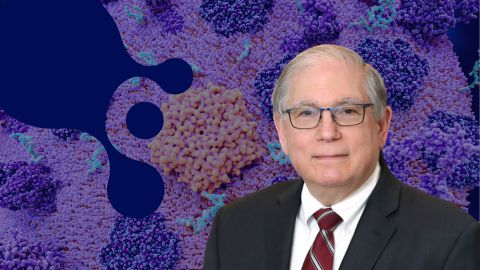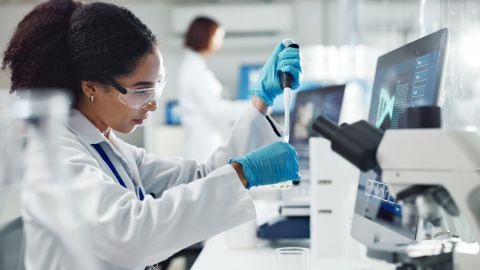
‘The implosion of the large laboratory business model’
As director of the National Institute of General Medical Sciences, Jon Lorsch oversees a $3 billion budget that supports almost 5,000 researchers, many of whom are members of the American Society for Biochemistry and Molecular Biology.
For many years, in fact, Lorsch was an ASBMB member. Before being tapped by the National Institutes of Health, he was on the faculty at the Johns Hopkins University School of Medicine, where he ran a lab focused on RNA biology. He continues to work on the molecular mechanisms of protein synthesis as a senior investigator at the Eunice Kennedy Shriver National Institute of Child Health and Human Development.

Lorsch spoke with ASBMB Today about the most pressing challenges scientists are facing today, with particular emphasis on how they’re being asked to do more with less funding and what can be done to make the field more diverse and inclusive for the next generation of scientists.
The interview has been edited for length, clarity and style.
What do you think federally funded scientists need to be thinking about right now?
Lorsch: I believe two of the biggest challenges the community is facing right now are inflation and the cost of training. The inflation of goods and services is having a significant impact on the scientific community. In addition, the cost of lab trainees such as postdocs is on the rise.
In academic science, we need to separate the research workforce from the pool of students and postdocs receiving training and professional development by working in labs. In terms of salaries, graduate students receive a degree, and we need to remember that the degree has monetary value. On the other hand, a postdoc position used to be the gateway to an academic job. That is no longer the case because most postdocs do not end up as faculty in academia.
In addition, many industry jobs no longer require postdoctoral positions. We know that there is a very large opportunity cost for completing a postdoc. Donna Ginther, distinguished professor of economics at the University of Kansas, did a lot of research on this topic and actually calculated how costly a postdoc can be to many early-career scientists if they do not end up taking a job that required a postdoc. This cost includes lost wages, benefits, retirement savings, career progression, etc. Principal investigators need to realize that postdocs are not cheap labor.
I also think the size of labs has gotten way too big. Scientists need to contemplate what is the most efficient lab size and reconsider how we perceive success. In my opinion, success should not be equated with having a 25-person lab. I believe having a smaller lab is more efficient and productive because we can provide better training to our Ph.D. students and postdocs and more direct input into and oversight of the research.
Overall, my interpretation of what many are referring to as the “postdoc crisis” is that it is the long-predicted implosion of the large laboratory business model, in which trainees are used as low-cost labor.
What is NIGMS doing to help address some of these challenges?
Lorsch: The MIRA program is one of our flagship initiatives, and we are trying to use it to address several challenges in the current research model. To address inflation, we are trying to increase the median and mode of MIRA funding to $300,000 of direct costs, which would be more than current NIGMS R01 funding and would help offset some of the losses to inflation that have taken place recently.
In addition, we are working to get early-career investigators funded earlier. Early-stage investigators, ESIs, receiving MIRA grants are, on average, getting funded a year or more sooner than ESIs funded by NIGMS R01s. We would like to see them funded even earlier through MIRA, but for this to happen they have to apply as soon as they start their independent positions. We are trying to get the message out to department chairs and others that they should be advising their new hires working in NIGMS’ mission areas to apply for MIRA as soon as they arrive rather than waiting until they have preliminary data or publications from their labs.
Another important aspect of MIRA is that it gives researchers the flexibility to follow new ideas or observations as they arise, rather than being bound to predetermined specific aims the way they are with R01s. This flexibility reflects how science actually works and how discoveries get made.
What do ASBMB members need to know about diversity, equity, inclusion and accessibility efforts at NIGMS?
Lorsch: We have a number of programs for undergrads — like MARC and U-RISE — and for graduate students — like G-RISE and IMSD.
To support the postdoc-to-PI transition, we began the MOSAIC program, which is a K99/R00 award. We began MOSAIC at NIGMS, but now many NIH institutes participate. Through this program, we have also set up mentoring centers with scientific societies, of which ASBMB has been a big part.
Kenny Gibbs runs the MOSAIC program and has been to meetings with scholars at the mentoring centers who have told him that, before they received a MOSAIC award, they were on the verge of dropping out of academia. Now, they actually have academic positions as independent investigators. So, as Kenny says, MOSAIC is doing something important.
In addition, we are about to launch the ARC program. This program will provide Ph.D.-to-postdoc transition support in the form of a F99/K00 award. We really try to target these transition points because that is where we lose so many scientists and so much diversity.
Another thing we are focusing on at NIGMS is building clinician scientist training programs such as M.D./Ph.D. training. The Medical Scientist Training Program is a great program, but the grants usually only go to the top 25 research institutions in terms of NIH funding. To broaden access to clinical scientist training, we recently launched a second program, similar to the MSTP, with eligibility limited to historically Black colleges and universities, tribal colleges and universities and institutions in IDeA states called Leading Equity and Diversity in the Medical Scientist Training Program, LEAD MSTP.
We want to recognize and support folks who are doing DEIA work, and we realize that this takes time away from their research. So, we created the NIH UNITE ReWARD R01 grant, which supports independent researchers who have made significant contributions to DEIA and who currently do not have a major NIH grant.
Finally, we want to expand our shared technology resources program at the national and regional levels with the R24 program. This program allows better access to high-end instruments for researchers across the country, regardless of the institution they are from. With this shared resource model, not every institution has to buy and maintain its own cryo-electron microscope or NMR spectrometer.
What advice do you have for early-career scientists?
Lorsch: My advice for early-career investigators is to shift the balance in your labs toward longer-term employees. I think having one or two graduate students and postdocs, a staff scientist and a technician is a great investment to train the next generation but also contribute to the sustainability of your lab and the research enterprise. This kind of model creates long-term, sustainable jobs for Ph.D. scientists who don’t necessarily want to be independent investigators.
And of course, apply for funding right away. There are tons of great programs out there.
Enjoy reading ASBMB Today?
Become a member to receive the print edition four times a year and the digital edition monthly.
Learn moreGet the latest from ASBMB Today
Enter your email address, and we’ll send you a weekly email with recent articles, interviews and more.
Latest in Policy
Policy highlights or most popular articles

Embrace your neurodivergence and flourish in college
This guide offers practical advice on setting yourself up for success — learn how to leverage campus resources, work with professors and embrace your strengths.

ASBMB honors Lawrence Tabak with public service award
He will deliver prerecorded remarks at the 2025 ASBMB Annual Meeting in Chicago.

Summer internships in an unpredictable funding environment
With the National Institutes of Health and other institutions canceling summer programs, many students are left scrambling for alternatives. If your program has been canceled or delayed, consider applying for other opportunities or taking a course.

Black excellence in biotech: Shaping the future of an industry
This Black History Month, we highlight the impact of DEI initiatives, trailblazing scientists and industry leaders working to create a more inclusive and scientific community. Discover how you can be part of the movement.

ASBMB releases statement on sustaining U.S. scientific leadership
The society encourages the executive and legislative branches of the U.S. government to continue their support of the nation’s leadership in science.

ASBMB and advocacy: What we accomplished in 2024
PAAC members met with policymakers to advocate for basic scientific research, connected some fellow members with funding opportunities and trained others to advocate for science.

